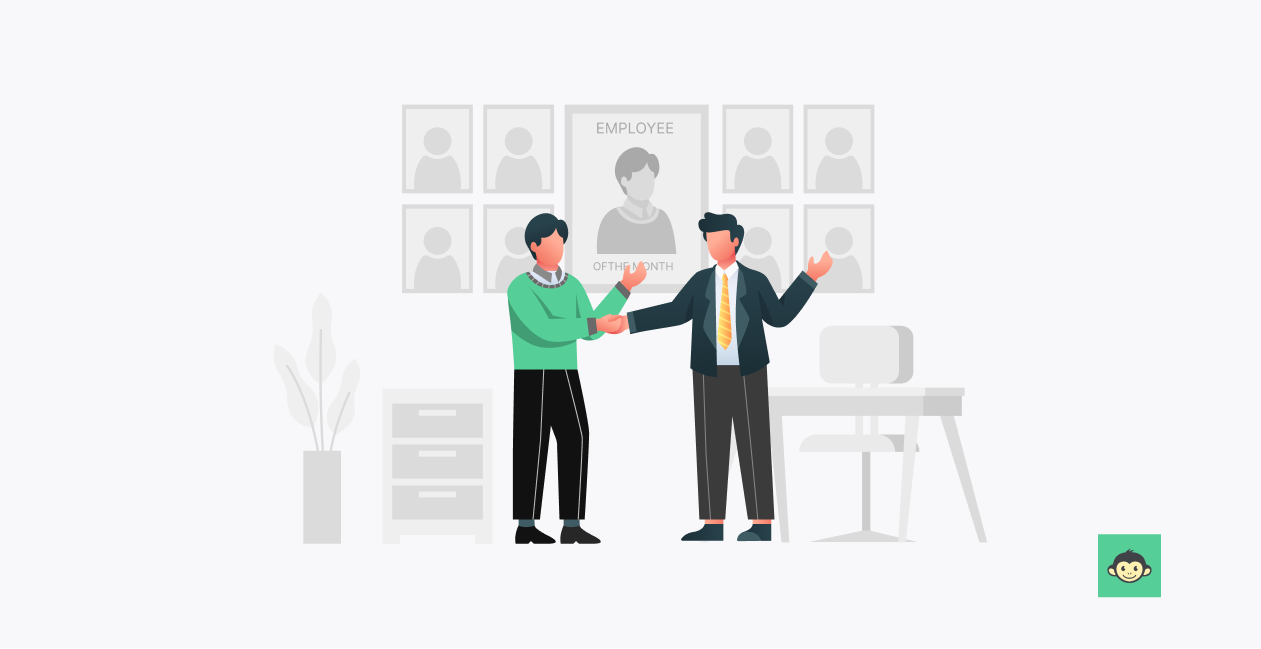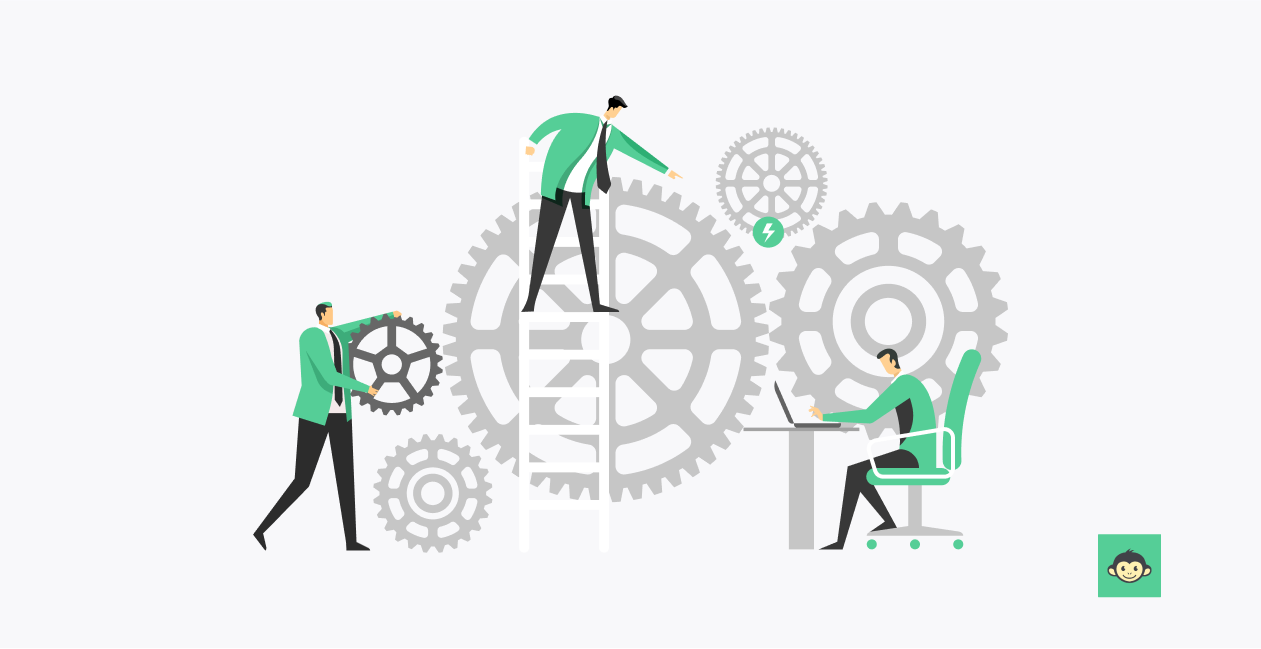How to retain employees: Examples & effective strategies to reduce your turnover rate in 2024

Retaining employees has become the ultimate puzzle for many companies. It's like trying to keep your favorite ice cream from melting on a scorching summer day. You know it's precious, but it's all too easy to watch it slip away.
In 2024, with the job market more dynamic than ever, retaining talented employees has become a strategic imperative. According to the Bureau of Labor Statistics, the average turnover rate in the United States reached 19.3% in 2022.
That's a significant chunk of your workforce potentially walking out the door each year, taking with them their skills, experience, and knowledge. It's like losing puzzle pieces essential to completing your organizational picture.
But fear not! Just as there are ingenious ways to keep your ice cream from melting—like enjoying it in the shade or using a well-insulated cooler—there are effective employee retention strategies and examples you can implement to reduce your turnover rate and ensure your employees stick around.
In this blog, we'll dive into employee retention strategies, and arm you with the knowledge to create a workplace where employees not only want to stay but also thrive.
What is employee retention?

Employee retention, put simply, is the art and science of keeping your valuable team members happy, motivated, and committed to your organization for the long haul. Think of it as tending to a flourishing garden.
Just as a gardener nurtures plants to ensure they thrive and continue to bloom, employers cultivate a nurturing environment that encourages their employees to stay and flourish within the company.
In the world of business, it's essential to understand that employee retention isn't just about preventing your workforce from seeking greener pastures elsewhere. It's about creating a positive atmosphere where employees are not only content but also enthusiastic about contributing their best efforts day in and day out.
In other words, it's about turning your workplace into a thriving ecosystem where talent and dedication grow naturally.
Why should you care about employee retention?

Imagine your organization as a ship navigating turbulent waters. Now, think of your employees as the sturdy crew members who keep that ship afloat. Their knowledge, skills, and dedication are the very wind that fills your sails and propels you forward. This analogy highlights why you should care deeply about employee retention in 2024.
In a world where talent is constantly on the move, retaining your best employees is akin to securing your ship's vital crew members. Let's look at the specifics of why you should prioritize employee retention:
Cost savings
Losing employees can be costly. Replacing them involves recruitment, an onboarding process, and training expenses.
According to the Society for Human Resource Management (SHRM), it costs an average of six to nine months' of an employee's salary to replace a mid-level employee. Keeping your existing talent on board is like plugging holes in your financial ship, ensuring it doesn't leak resources.
Productivity and continuity
High turnover disrupts workflow and productivity. New employees often need time to acclimate and reach peak performance.
Retaining your experienced staff ensures that your ship sails smoothly, avoiding choppy waters and maintaining operational consistency.
Customer satisfaction
Satisfied, engaged employees provide better customer service. Like a ship's crew offering top-notch hospitality to passengers, happy employees are more likely to create positive customer experiences, increase employee engagement, ultimately enhancing your brand reputation.
Innovation and growth
Your long-term crew members have a deeper understanding of your ship's journey and destination. They're more likely to contribute innovative ideas and drive growth initiatives. Retaining them ensures a steady course toward success.
Company culture
Employee retention is closely tied to your company's culture. A high turnover rate can disrupt the culture you've carefully cultivated, potentially causing unrest among the remaining crew. Retaining employees helps preserve the positive culture you've worked hard to establish.
Knowledge transfer
Just as seasoned sailors pass down their knowledge to new recruits, experienced employees can mentor and transfer critical skills to newcomers. Losing this knowledge can be detrimental to your organization's long-term success.
Employee morale and team dynamics
Maintaining high employee retention fosters a positive morale within the workforce.
When employees see their colleagues staying with the company for the long haul, it boosts their morale and creates a sense of stability and camaraderie. Strong team dynamics contribute to smoother collaboration, problem-solving, and overall productivity.
Employee loyalty and advocacy
Long-tenured employees are more likely to develop a sense of loyalty towards the organization. They become brand advocates, speaking positively about the company both within and outside the workplace.
Employee retention is the compass that keeps your ship on course. It's not just about preventing departures; it's about ensuring your crew is motivated, engaged, and aligned with your organizational goals.
What are the three pillars of employee retention?

1. Engagement and recognition
Think of employee engagement as the fuel that keeps the engine running smoothly. Engaged employees are committed, enthusiastic, and connected to their work. Just as a well-tuned engine powers a vehicle efficiently, engaged employees drive your organization forward.
Recognizing their efforts is like adding premium fuel to that engine, increasing its efficiency and performance. Providing regular feedback, acknowledging achievements, and offering opportunities for growth are all essential components of this pillar.
2. Work-life balance and flexibility
Achieving work-life balance is like maintaining the equilibrium of a seesaw. When employees can balance their professional responsibilities with their personal lives, employees feel happier and more productive.
Much like a seesaw that remains steady when evenly weighted, a balanced work-life equilibrium prevents burnout and turnover. Offering flexibility, such as remote work options or flexible hours, is a key part of this pillar, allowing employees to juggle their work and personal commitments effectively.
3. Career development and growth
Professional development is akin to providing a ladder for employees to climb aboard and reach new heights. Just as a ladder facilitates upward mobility, offering opportunities for skill development, advancement, and learning within your organization is crucial.
Employees who see a clear path for career growth and development are more likely to stay on board for the long haul. Providing training programs, mentorship, and a well-defined are essential aspects of this pillar.
These three pillars form the sturdy foundation of your retention strategy in 2024. By focusing on these aspects, you'll create an environment where your employees want to stay and thrive, contributing their best to your organization's success.
What is employee turnover?

Picture your organization as a bustling train station, with employees representing the passengers on this journey.
Employee turnover, in this context, is akin to passengers disembarking from the train at various stops along the way. It refers to the rate at which employees leave your company and need to be replaced by a new employee.
In 2024, the turnover rate is a critical metric, much like tracking how many passengers hop on and off your train. High turnover means a constant influx of new passengers, each requiring a ticket, a seat, and some guidance on their journey.
Conversely, low turnover indicates that your train is steadily moving forward with a stable group of passengers who are familiar with the route, making the ride smoother and more cost-effective.
Employee turnover can be voluntary, where employees choose to leave for various reasons like better opportunities or dissatisfaction, or involuntary, where the organization decides to part ways with employees due to performance issues or restructuring.
It's essential to monitor and manage turnover, as excessive departures can disrupt your organization's momentum, increase costs, and impact morale among those who remain on the train.
Why is retention challenging in HR?

Retaining employees in the realm of Human Resources (HR) can be challenging for several reasons, much like navigating through a maze. Let's explore some of the key challenges HR professionals face when it comes to employee retention:
Diverse workforce needs
Your employees are like a diverse group of travelers, each with unique preferences and expectations. HR must cater to the varied needs of different employees, from millennials seeking career growth to Gen Xers valuing work-life balance.
Balancing these diverse needs can be akin to managing a bustling international airport with flights headed in various directions.
Changing job market
The job market is in constant flux, much like turbulent weather patterns at sea. Economic conditions, emerging industries, and evolving job opportunities can entice employees to explore new horizons.
HR professionals must continually adapt their employee retention strategies to remain competitive in this ever-changing landscape.
Skills shortages
Just as a ship needs a skilled crew to navigate tricky waters, organizations require a skilled workforce to thrive. However, industries often face skills shortages. HR must address this challenge by attracting and retaining top talent, sometimes in fields where demand significantly outpaces supply.
Remote work and hybrid models
The rise of remote work and hybrid models is transforming the employment landscape.
HR must navigate the complexities of managing and retaining employees who may never set foot in a physical office. Ensuring remote employees feel connected, engaged, and supported is a new challenge on the HR horizon.
Company culture and values
Maintaining a cohesive culture is vital, much like ensuring everyone on board a ship follows the same course.
As organizations grow or adapt to changing circumstances, HR must work to preserve and promote the core values that bind employees together. Failure to do so can result in cultural disconnects and higher turnover.
Competitive market for talent
Attracting and retaining top talent is akin to securing precious treasures in a competitive market. Other companies are vying for the same skilled individuals, making it challenging to retain key personnel. HR must continuously evolve its recruitment and retention strategies to remain competitive.
Burnout and well-being
Preventing employee burnout and safeguarding their well-being is crucial. Just as a ship's crew needs rest to perform optimally, employees must have a healthy work-life balance.
HR professionals must actively address issues related to mental health, stress, and burnout, which can contribute to turnover if left unchecked. An org must be committed to cultivating a healthy work life balance.
Generational differences in expectations and preferences
With a multi-generational workforce, HR faces the challenge of accommodating varying expectations and preferences.
Baby boomers may prioritize stability and traditional benefits, while millennials and Gen Z workers might seek flexible work arrangements and opportunities for skill development.
Technological advancements and digital transformation
The rapid pace of technological advancement and digital transformation reshapes how work is done and the skills required. HR professionals must navigate this digital landscape to attract and retain employees with the necessary technical expertise.
Retention is a complex puzzle that HR professionals must solve continuously. The ever-changing nature of the job market, the diverse needs of employees, and the evolving dynamics of work all contribute to the challenge.
Like skilled navigators, HR must adapt, steer the ship, and use innovative new employee retention strategies to keep employees on board and motivated in 2024 and beyond.
19 Employee retention strategies to try in 2024

1. Peer recognition programs
Encourage employees to recognize and appreciate each other's contributions. Like crew members applauding their colleagues' efforts, peer recognition fosters a positive and supportive workplace culture.
2. Learning and development budgets
Provide employees with a dedicated budget for their professional development. Just as a ship's crew benefits from ongoing training, empowering employees to choose their learning opportunities increases engagement and loyalty.
3. Employee sabbaticals
Offer extended leaves of absence or sabbaticals for employees to recharge and pursue personal interests. This is like allowing your crew members to take a well-deserved break to return with renewed energy and commitment.
4. Flexible benefits packages
Allow employees to customize their benefits packages to meet their unique needs. Similar to a menu with various options, flexible benefits give employees a sense of control over their perks and incentives.
5. Job rotation programs
Implement job rotation initiatives that allow employees to explore different roles within the organization. Like crew members experiencing different ship duties, job rotations keep work fresh and employees engaged.
6. Regular town hall meetings
Conduct regular town hall meetings where leadership shares company updates, future plans, and welcomes questions and suggestions. This open communication builds trust and keeps employees informed about the ship's course.
7. Employee well-being platforms
Invest in digital platforms that promote employee well-being, providing resources for physical fitness, mental health, and stress management. It's like having a virtual wellness center on board to cater to your crew's needs.
8. Diversity, equity, and inclusion initiatives
Commit to fostering a diverse and inclusive workplace. Develop and communicate policies and initiatives that promote diversity, equity, and inclusion, creating an environment where all employees feel valued and heard.
9. Performance feedback loops
Establish continuous positive feedback loops between managers and employees. Regular, constructive feedback is essential for professional growth and helps address issues before they escalate into retention challenges.
10. Cross-functional teams
Encourage employees to collaborate on cross-functional teams or projects. Much like a ship's crew working together to navigate obstacles, cross-functional teams promote teamwork and innovation.
11. Transparency in compensation
Ensure transparency in compensation structures and salary ranges. When employees understand how their pay is determined, it minimizes potential dissatisfaction related to compensation.
12. Family-friendly policies
Introduce family-friendly policies such as extended parental leave, on-site childcare facilities, or flexible scheduling to support employees in balancing their work and family responsibilities.
13. Social responsibility initiatives
Engage employees in socially responsible initiatives, such as community volunteering or sustainability efforts. Just as a ship contributes to the environment, these initiatives foster a sense of purpose beyond daily tasks.
14. Regular pulse surveys
Conduct regular employee pulse surveys to gauge satisfaction levels and gather feedback. These surveys act as your ship's sonar, helping you navigate potential obstacles below the surface. Use the insights to make data-driven decisions and address issues promptly.
15. Flexible work arrangements
Offering flexible work arrangements, such as compressed workweeks or remote options, is like adjusting sails to accommodate changing winds.
It allows employees to balance their professional and personal lives effectively, increasing employee job satisfaction, and reducing the likelihood of departure.
16. Employee resource groups
Establish employee resource groups or affinity networks. These groups create a sense of belonging and inclusion, like having close-knit crews within a larger ship.
Encourage employees to connect with colleagues who share similar backgrounds, interests, or experiences. Such connections foster a sense of community and loyalty.
17. Mentorship and coaching programs
Implement mentorship and coaching programs to facilitate knowledge transfer and skill development. Just as experienced sailors pass down their wisdom, senior employees can guide newer ones, creating a sense of camaraderie and professional growth.
18. Recognition beyond monetary rewards
Recognize and reward employees beyond monetary incentives. Sometimes, your employees expect more than a thank you or a pat on the back. Acknowledge their contributions publicly, celebrate milestones and showcase their achievements.
This recognition is like hoisting a flag to honor outstanding crew members, fostering a culture of appreciation.
19. Continuous culture assessment
Regularly assess and adapt organizational culture to align with employee needs and values.
Just as a ship adjusts its sails according to changing winds, evolving company culture ensures that employees feel supported and connected to the organization's mission and values.
By implementing these diverse retention strategies, you can create a workplace in 2024 where employees not only want to stay but also thrive, contributing their best to your organization's continued success.
How to retain Gen Z employees?

As Generation Z (Gen Z) enters the workforce, organizations face the challenge of understanding and retaining this unique demographic.
Born between the mid-1990s and early 2010s, Gen Z employees bring distinct values, preferences, and expectations to the workplace.
Embrace technology:
Gen Z employees are digital natives who grew up immersed in technology. To retain them, organizations must leverage technology in all aspects of the employee experience, from recruitment to daily operations.
Implementing digital communication tools, collaboration platforms, and mobile-friendly HR systems not only aligns with Gen Z's preferences but also enhances their productivity and engagement.
Offer meaningful work:
Gen Z values purpose-driven work and seeks opportunities to make a meaningful impact. To retain Gen Z employees, organizations should align job roles with their interests, passions, and values.
Providing challenging projects, autonomy, and opportunities for innovation empowers Gen Z workers to contribute their best and fosters a sense of fulfillment and purpose in their roles.
Provide growth opportunities:
Gen Z employees are ambitious and eager to learn and grow in their careers. Offering continuous learning and development opportunities is essential for retaining them. Implement mentorship programs, skills training workshops, and career advancement pathways to support
Gen Z's professional growth aspirations. Providing regular feedback and recognition for their achievements also reinforces their commitment to the organization.
Foster diversity and inclusion:
Gen Z values diversity and inclusivity in the workplace and seeks environments where they feel respected and valued for their unique perspectives and identities.
To retain Gen Z employees, organizations must prioritize diversity and inclusion initiatives, such as promoting diverse hiring practices, creating inclusive policies, and fostering a culture of belonging where everyone feels welcome and accepted.
Promote work-life balance:
Achieving a healthy work-life balance is crucial for Gen Z's well-being and retention. Organizations should offer flexible work arrangements, remote work options, and ample time-off policies to support Gen Z's lifestyle preferences and personal commitments.
Encouraging boundaries between work and personal life and providing resources for stress management and mental health support demonstrates a commitment to Gen Z's overall well-being and retention.
How can an employee retention software help you retain your employees?

Leveraging technology can be a game-changer in an org’s plan to retain employees. Employee retention software is like a compass that helps steer your ship through the complex waters of workforce management. Here's how it can aid in your retention efforts:
Data-driven insights
Employee retention software can collect and analyze data on employee engagement, satisfaction, and performance. It's like having a radar system that detects potential retention challenges early. These insights allow you to take proactive measures to address issues and keep employees on board.
Personalized employee engagement
Just as GPS offers personalized navigation, retention software can tailor engagement strategies to individual employees. It tracks their preferences, career goals, and feedback, enabling you to provide customized support and development opportunities.
Performance monitoring
The software can continuously monitor employee performance and provide real-time feedback. It's like having an automated performance evaluation system that helps employees stay on course and improve their skills.
Feedback and surveys
Employee retention software often includes survey tools for gathering feedback. Like conducting regular ship inspections, these surveys help you assess employee satisfaction and identify areas for improvement.
Automation of administrative tasks
By automating HR administrative tasks, such as leave requests and benefits management, the software frees up HR professionals to focus on strategic retention initiatives. It's like having a crew of robots to handle routine ship maintenance, allowing the human crew to concentrate on navigation and safety.
Recognition and rewards tracking
Many retention software solutions incorporate recognition and rewards programs. This feature is akin to an onboard rewards system that acknowledges and incentivizes employees for their contributions.
Succession planning
Retention software often includes tools for succession planning, identifying high-potential employees, and nurturing their growth within the organization. It's like a talent scouting program that ensures a steady supply of skilled crew members for your journey.
Conclusion
By implementing a combination of effective retention strategies, harnessing the power of technology through employee retention software, and creating a workplace that fosters growth, inclusion, and well-being, you can ensure that your employees not only stay on board but also actively contribute to your organization's journey toward prosperity.
Learning how to retain employees involves navigating the complexities of workforce management with dedication and a forward-thinking approach. With this, you can anchor your workforce in 2024 and beyond, charting a course for a brighter future together.
FAQs
What is the average employee turnover rate in 2024?
As of my last knowledge update in September 2021, I don't have access to real-time data. Employee turnover rates can vary by industry, region, and economic conditions. It's best to consult current HR reports, industry benchmarks, or government labor statistics for the most accurate turnover rate data in 2024.
How can I improve employee retention on a tight budget?
You can enhance employee retention without a significant budget by focusing on intangible factors like communication, recognition, and professional development. Foster a positive work environment, provide regular feedback, offer skill-building opportunities, and acknowledge employees' contributions. Encourage work-life balance and consider non-monetary incentives like flexible schedules and remote work options.
Is employee turnover always a bad thing?
Not necessarily. While high turnover can be detrimental, some turnover can be healthy for an organization. It allows for fresh perspectives, new skills, and can remove underperforming employees. The key is to manage turnover strategically, retaining top talent while addressing performance issues and filling critical roles promptly.
What role does company culture play in retention?
Company culture plays a significant role in employee retention. A positive, inclusive, and values-driven culture fosters a sense of belonging and engagement. Employees are more likely to stay in an environment where they feel appreciated, aligned with the company's mission, and have opportunities for growth and advancement.
Can employee retention software work for small businesses?
Yes, employee retention software can benefit small businesses. While smaller companies may have limited resources, these tools can help streamline HR processes, identify retention risks, and enable data-driven decisions. Look for cost-effective solutions tailored to the needs and size of your organization to maximize the benefits of retention software while staying within budget.
What is a good retention strategy?
A good employee retention strategy encompasses a multifaceted approach that prioritizes employee satisfaction, engagement, and development. It involves creating a positive work environment where employees feel valued, supported, and motivated to contribute their best. Effective employee retention strategies include providing opportunities for growth, promoting work-life balance, offering competitive benefits, fostering strong relationships between employees and leadership, and implementing recognition programs.
Why do companies fail to retain employees?
Companies fail to retain employees for various reasons, including inadequate career development opportunities, poor work-life balance, insufficient recognition and appreciation, ineffective leadership, and lack of organizational culture alignment. Additionally, companies may struggle with low employee engagement and inadequate communication. Failure to address these factors can lead to decreased morale, increased turnover rates, and difficulty in attracting and retaining top talent.
How do you retain an employee who wants to leave?
To retain an employee who wants to leave, it's crucial to engage in open and honest communication to understand their reasons for wanting to depart. Address their concerns promptly and constructively, offering solutions or accommodations whenever possible. Provide opportunities for professional growth and development that align with their career aspirations. Demonstrate appreciation for their contributions and value to the organization.
What are the six main drivers of retention?
The six main drivers of retention are:
- Career development opportunities
- Compensation and benefits
- Work-life balance
- Recognition and appreciation
- Leadership and management
- Organizational culture
These factors play pivotal roles in influencing employee satisfaction, engagement, and loyalty within an organization. Addressing these drivers effectively can significantly contribute to retaining top talent and fostering a positive workplace environment.
What are the best employee retention strategies?
The best employee retention strategies encompass a combination of approaches tailored to meet the unique needs and preferences of employees. These may include providing opportunities for career development and advancement, offering competitive compensation and benefits packages, promoting a healthy work-life balance, implementing recognition and appreciation programs, fostering strong leadership and management practices, and cultivating a positive organizational culture.



